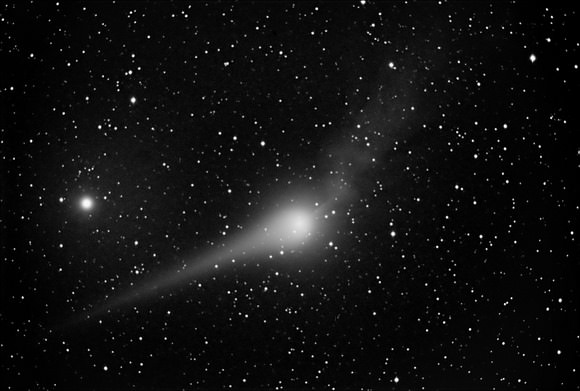[/caption] We've received a few emails asking for more information about how to attempt to observe Comet Lulin. And Sky and Telescope has put out a great primer for seeing this green smudgeball in North America. Right now is the optimum time to try and see it. Sky and Telescope editor-in-chief Robert Naeye says Lulin should be at its best from Feb. 23 through the 28th. "In a very dark, unpolluted, natural night sky -- such as few people see any more -- the comet is dimly visible to the unaided eye," writes Naeye. "Even in a more light-polluted suburban sky, however, a good pair of binoculars will do the trick. But you have to know exactly where to look."
Start looking for Lulin after 9:00 pm (your local time) but the view will be better after 10:00 pm.
Here's a star chart from SkyandTelescope.com/CometLulin.
And here's the info from S&T:
[caption id="attachment_26144" align="aligncenter" width="298" caption="Lulin's path. Credit: SkyandTelescope.com"]
[/caption]
"It shows the starry view high in the east-southeast in mid-evening. You should have no trouble spotting the planet Saturn and the star Regulus in the constellation Leo. They're the two brightest things in the area.
"Using those as your guide, aim at the point on the comet's path that's labeled with the current date. The comet's position is indicated for the evening hours on each date for the time zones of the Americas. The orientation of the scene with respect to the horizon is drawn for North America.
"You're looking for a very dim, biggish, slightly oval cotton-puff floating among the tiny pinpoint stars. Look carefully, and you may detect the spike of the comet's "anti-tail" pointing toward the lower left. The comet's regular tail is actually dimmer, and it points in almost the opposite direction. In binoculars the whole thing looks more gray than greenish; to see color you need more light. In a large amateur telescope, the color and the comet's structure are a lot more clearly visible.
"I saw it out my bathroom window with 10-by-50 binoculars," says Alan MacRobert, a senior editor of Sky & Telescope. "It's pretty plain if you get aimed at exactly the right spot."
For more about Comet Lulin, its discovery, the reason for its two tails, check out Universe Today's previous articles:
one by Tammy about Lulin's twisty tails
, and one by Nancy,
"Comet Lulin is on the Way!".
Check out Spaceweather.com's posting of pictures of Lulin from astronomers from all over the world.
 Universe Today
Universe Today
